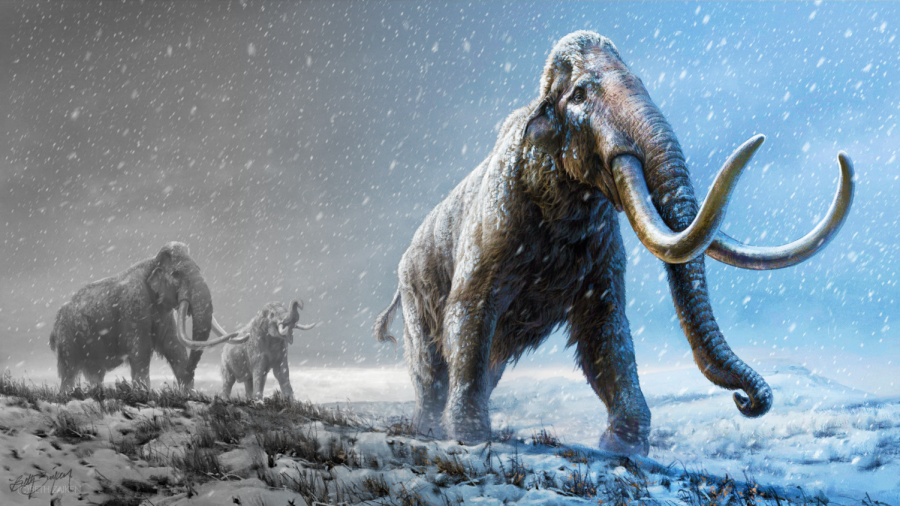Op-Ed: Bringing back the woolly mammoths is a colossal mistake
Original photo by Scientific American, designed by Jessica Lin
Scientists want to bring woolly mammoths back from the past.
The novel Jurassic Park brought readers a glimpse of a fantastical world: a theme park full of dinosaurs. The gigantic creatures, once only limited to the imagination, became reality through technology. People toured the island with amazement, assured by the owner that it was completely safe. However, while first regarded as a scientific marvel, the park eventually proved to be a violence-filled disaster. There were many casualties as a result of man’s attempt to control nature. Now, a start-up, Colossal Laboratories & Biosciences, wants to try something similar. However, instead of dinosaurs, it’s woolly mammoths they’re trying to bring back. The company’s timeline wants to bring the creatures back in an alarming six years.
Colossal is dedicated to using genetic research in order to fight extinction. One of its main goals involves splicing DNA from frozen mammoths and Asian elephants, but they don’t just want to bring back an extinct species. The company wants to reintroduce the woolly mammoths into the environment, which they claim will reverse climate change. While I’m all for scientific development, Jurassic Park already showed us what happens when we try to play God. I fear this is another case of overeager scientists clamoring for something new without fully considering the ramifications. Plus, if climate altruism is truly the objective, the investment money would be better spent in existing global warming prevention efforts.
First, let’s focus on the overarching ethical debate. Should humans be allowed to bring extinct species back to life? While the concept is certainly interesting, extinction is a consequence of nature. Mammoths went extinct 4,000 years ago because melting icebergs destroyed their habitat, a result of the end of the Pleistocene Ice Age. The Earth has been constantly changing since its formation, and it makes sense that the animal life on it would as well. Additionally, we need to remember that we’re talking about living creatures. According to Matthew Cobb, a professor of zoology at the University of Manchester, mammoths are “a social animal”. Would it be in the best interest of the species to bring a few isolated individuals back into an ecosystem that’s had thousands of years to change?
It should be noted that this change in environment is the reason why Colossal wants to bring the mammoths back. According to Ben Lamm, the CEO of Colossal, “The eventual goal is to return the species to the region so that they can reestablish grasslands and protect the permafrost, keeping it from releasing greenhouse gases at such a high rate.” Mammoths do this by brushing snow off the ground, allowing cool air to reach the permafrost. While I can certainly get behind the idea of climate action, the reasoning for releasing these quasi woolly mammoths into the wild involves too many hypotheticals. We don’t know if these mammoths will survive in modern environments, and there’s no telling how they might impact the existing biodiversity. Even if the mammoths manage to survive, a small handful won’t save the tundra. According to Victoria Herridge, an evolutionary biologist at the Natural Museum, it’s estimated that there were 200 million mammoths 20,000 years ago roaming Eurasia, which is the scale required to affect the permafrost. Mammoths are in gestation for almost two years and take 30 years to mature. One doesn’t have to be a mathematician to see that it’d be impossible to assemble enough mammoths to have the effect on climate change we currently need.
To view this from an economic standpoint, a 2017 study from Harvard University found that the funds associated with bringing back mammoths would only contribute to a small increase in biodiversity in the world. In comparison, if the money went to existing conservation efforts, there would be a greater increase in biodiversity. Currently, Colossal has gotten $15 million from investors. While it’s true that investors are free to do whatever they want with their money, it would be more valuable to convince the investors to spend their money on efforts we know will make a difference. The investments received by the company are likely due to the fact that it’s promising something new and shiny: the possibility of being on the frontier of scientific research. We need to figure out ways to get investors just as excited about more effective, albeit mundane, ways to save the climate.
Ultimately, I believe that Colossal’s vision lies more in the prospect of doing something new rather than contributing to a better planet. Furthermore, it reinforces the incorrect mindset that we should be battling climate change with. Instead of developing solutions to fix the damage, we should be focused on preventative measures that minimize the damage in the first place. Colossal also states that it hopes to use the DNA splicing technologies to give endangered creatures genetic traits for survival, but this is another example of the aforementioned misplaced focus. Plus, if de-extinction technology is successful, some people might think they have an excuse to be even more careless about the environment. In reality, our planet will still need all the help it can get.
Instead of all these lofty ideas, Colossal should focus its resources on more grounded efforts that will create tangible changes right now. I’m not discouraging innovation, but we also need to think carefully about our actions. Is Colossal truly trying to bring back woolly mammoths for the sake of the planet, or is it more about fame and glory?
Your donation will support the student journalists of Carnegie Vanguard High School. Your contribution will allow us to cover our annual website hosting costs and fund field trips, competition fees, and equipment. We appreciate your support!

Hi, I'm Jessica! I am a senior and one of the Feature Editors for Upstream News. I love dance, Marvel, and cats.







Sasha Cabral • Dec 9, 2021 at 2:06 pm
I love how you pointed out the flaws and “what if’s” in the argument that bringing back Woolly Mammoths will help alleviate climate change.
Atahan Koksoy • Dec 9, 2021 at 1:59 pm
Nice article! I liked that you did a bunch of research, and also your message is a very relevant one. When we are losing our planet and current species, why bring back ones that went extinct thousands of years ago? The benefit of this technology I see is that it might yield some more specimens for study. For example, we have very little knowledge about what the dodo actually looked like, because all images we have are drawn from poorly stuffed dead birds, not live ones. Cloning a dodo might give us this idea. Second, we could use this technology to increase the numbers of endangered and “extinct in the wild” species, as you mentioned. Great job!
Ankitha Lavi • Dec 9, 2021 at 1:41 pm
Wow! I didn’t know that they were actually planning to bring back mammoths- I thought it was a conspiracy theory! I definitely agree with you on taking more idealistic measures in saving the climate, rather than just introducing an extinct species and hoping they will save the world. Great article!!